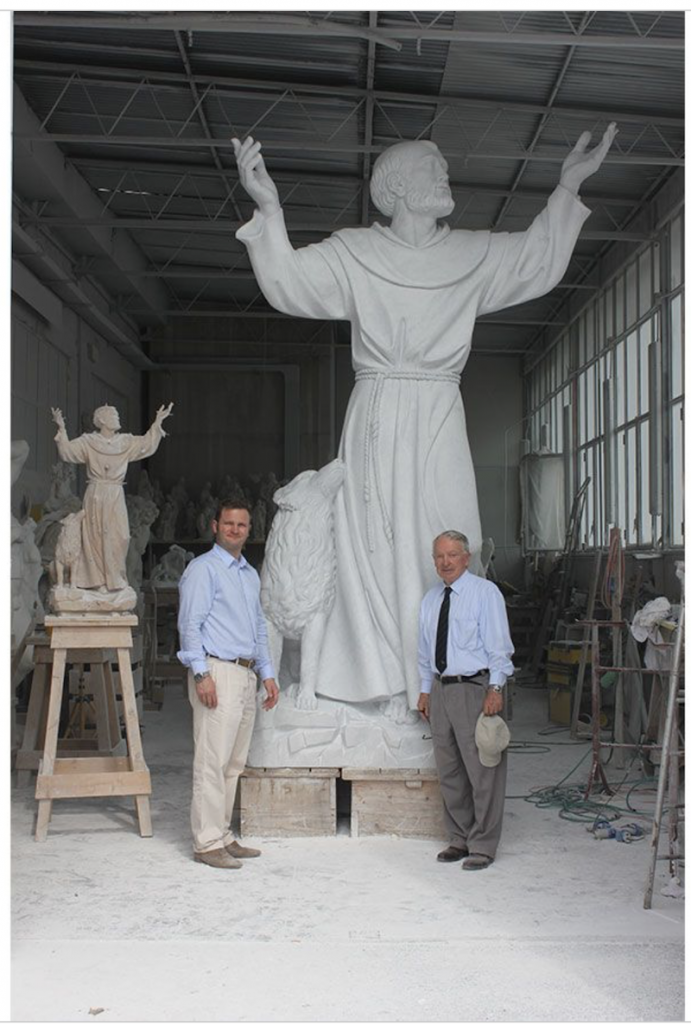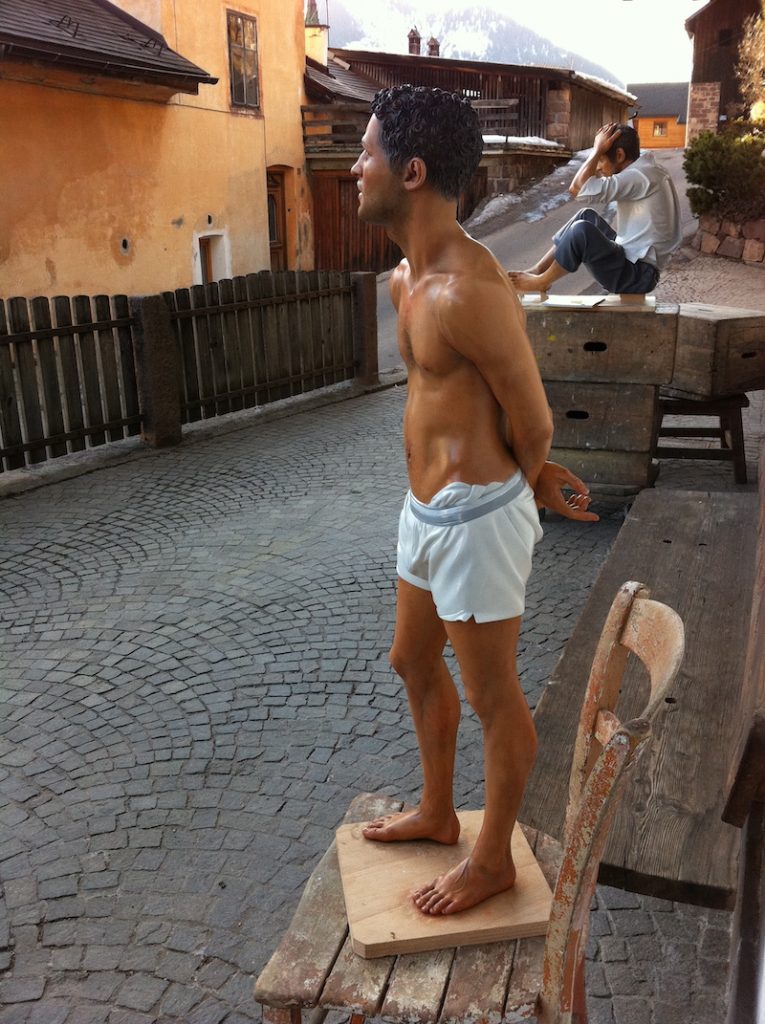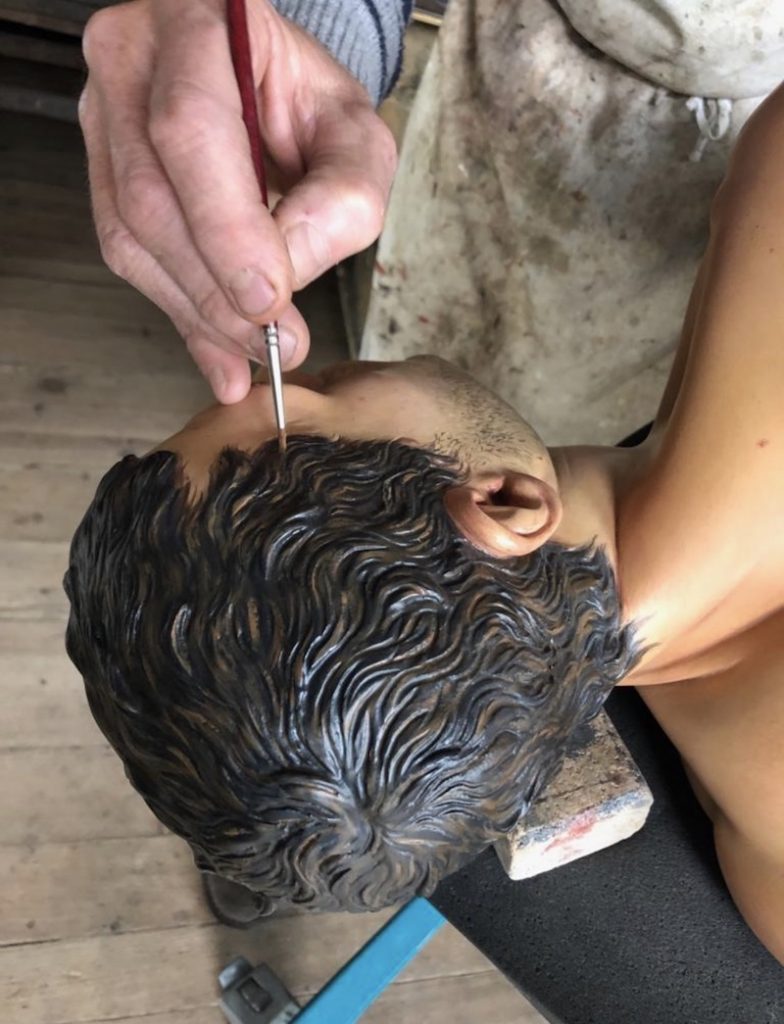I’m often asked how pieces of sculpture in the Fitzwilliam Museum were made, and so here’s an exclusive, step-by-step guide as to how Action 125: Tikrit city, Iraq. Monday, April 14, 2003 came into being.
I’ve chosen to focus on this visually stunning piece of polychrome wood sculpture because we’ve just purchased unique version 3/3, the last of the three available to buy (unique versions 1/3 and 2/3 are respectively in private collections in London and Paris). This strategic new acquisition was made possible thanks to funding from The Friends of the Fitzwilliam Museum. We are delighted to have been able to acquire this final version from Reza Aramesh considering how keen he was that it should end up in a public institution, where it could be seen by as many people as possible, and used in learning and outreach programmes to engage, inspire and generate debate.

You may remember that we borrowed unique version 1/3 of Action 125 last autumn as part of Sensual/Virtual: Two Coloured Sculptures, when it was juxtaposed with another, much earlier, polychrome wood sculpture: St Sebastian, likely made in Valladolid in the 1530s by Spanish Renaissance sculptor, Alonso Berruguete.

Although created nearly 500 years apart, under very different circumstances and for very different reasons, the materials and techniques used, as well as the three-quarter life-size scale and uncanny heightened naturalism are similar. The positive visitor reaction to Action 125 in this temporary exhibition, and the debates it generated, were key factors in our decision to acquire unique version 3/3.
Since a picture speaks a thousand words, my blog will take the form of a sequence of ‘fly on the wall’ images, which Reza has generously shared from his studio’s photographic archive. While they document the making of unique version 1/3, the other two versions were made in exactly the same way, but each is slightly different, as they are made entirely by hand. As you’ll see, the painstaking and time-consuming process of creation is one of consultation and collaboration, and the materials and techniques are very traditional. In fact, the whole process from start to finish is virtually identical to how Berruguete’s St Sebastian and our other historic pieces of polychrome wood sculpture were made – except for the use of digital images, of course!
Action 125 as part of Reza’s Action Series of 2010–2011
A bit of background for starters: Action 125 is a contemporary political subject: a Muslim Iraqi prisoner-of-war captured by invading American forces in Tikrit, Northern Iraq, on 14 April 2003, at the start of the Iraq War (2003–2011). It was made in 2011 as part of a larger Action Series, nine compositions each representing an act of subjugation, namely a lone male victim forced to strip down and left exposed, humiliated, and vulnerable.

Each of the nine compositions was produced as a unique version of three, and while similar to each other, each version is totally unique due to its having been entirely crafted by hand. Moreover, each version is distinguished through the use of differently coloured underwear. In the case of Action 125, version 1/3 has red and white striped underwear, version 2/3 has blue and white stripes; and our version has white, as you can see in the top image.
Reza Aramesh and the collaborative nature of sculpture production
The designer and lead artist of the whole Action Series is Reza Aramesh. Born in Iran, Reza fled from there as a teenager to avoid military service, and settled in London where he was able to pursue his career as an artist. In 1997, he obtained a Masters in Fine Arts from Goldsmiths University, London, and since then he has established an international reputation for his visually-stunning, politically-charged works of art. Reza is incredibly modest by nature and very camera shy, but here is a rare photo of him in May 2014, only three years after Action 125 was made, at work in his London studio, surrounded by his myriad research images that inspire and challenge him.

It’s important to note that Reza makes no pretence to having carved or painted any of the Action Series figures himself. His practice is conceptual, as is the case with many artists, not just now but historically. For example, Alonso Berruguete ran a large and successful workshop. From archival records and first-hand accounts, we know that he relied heavily on the use of skilled assistants and apprentices to work with him and perform specialist tasks. Due to guild regulations, the responsibilities for carving and colouring sculpture were normally carried out by different practitioners. Renaissance artists also operated in teams, often subcontracting parts of a project, but all working from an idea – a drawing or model – supplied by the lead artist, who would then direct operations with verbal instructions and only minimal manual intervention. And this is basically how Reza works too.
Reza’s collaboration with the Demetz Art Studio
Reza has worked for over ten years with the Demetz Art Studio. Famed for its high quality works of art, often of religious subjects for the Catholic church and other exacting ecclesiastical patrons, the Demetz Art Studio is a family affair now run by Reto Demetz, but still under the watchful eye of his father: you can see them both here in one of the large carving studios, dwarfed by a colossal statue of St Francis, and with other sculptures of Christian subject matter in the background.

The Demetz Art Studio is based in Ortisei, a small picturesque Alpine village nestled in the Val Gardena, a popular ski resort. This area is also well known for its wood carving, an industry that developed there centuries ago thanks to the abundant local supply of limewood, which is perfect for carving. You can see the forests clearly in this aerial view of the village.

Reza told me: ‘The studio’s incredibly stunning setting is breath-taking in every season. On my trips there to oversee work on my sculptures, I often reflect on how lucky I am to be producing them there.’ Here’s an evocative snap of two of Reza’s Action Series sculptures drying outside the painting studio!

The key Demetz Studio artists involved in making the Action Series are also part of long artistic dynasties, with creative DNA clearly in the blood. The sculptures were carved by master sculptors Mathias and Christian Verginer, twin brothers who learnt the art of wood carving from their father.
 And the impressive polychromy was applied by master painter Gustav Moroder, who learnt the art of polychromy from his mother.
And the impressive polychromy was applied by master painter Gustav Moroder, who learnt the art of polychromy from his mother.

Creating Action 125 using time-honoured materials and techniques
I’m now going to give you an exclusive ‘step-by-step’ account of how Action 125 was made, using time-honoured materials and techniques. The only real difference is the use of photographs (instead of drawings) as visual prompts to record the composition.
-
Establishing and recording the desired composition
As source materials for each sculpture in the Action Series, Reza selected various shocking reportage images of victims of war, conflict, and displacement, from Algeria and Korea in the 1950s to present-day Iraq and Palestine, published by print and online global news outlets. Action 125 was based on eight different photos taken by photo journalists at the start of the Iraq War, one of which is this Getty image.

Reza then had to choose an appropriate person to act as a live model. Significantly, he always collaborates with people he knows well or has met on many occasions, confiding that, ‘it is important that they have a very deep connection with the subject matter’. Reza and his assistant Vicky Thornton (now an artist herself) arranged an audition day for those whom he had approached to collaborate with him on the Action Series project. In the case of Action 125, the model chosen was David, who had originally been introduced to Reza through a friend. They had already worked together on several photographic projects, re-constructing reportage images of wars and displacements in stately homes in England. Vicky then organised a photo shoot for all the models to which Reto Demetz was invited to attend, all the way from Italy, so he could advise on the poses and confirm that they would be suitable for translating into wood. ‘Although the basic pose is clear in my mind’s eye before the photo shoot’, says Reza, ‘on the actual day there is a lot of spontaneity. I allow the personality of the model to come into play, and often certain gestures come to the fore, which I may not have considered while working on the initial composition.’ In the case of Action 125, Reza wanted the protagonist to be shown lying awkwardly and uncomfortably on the ground, arms tied behind the back, and face raised imploring upwards.

Once the pose was finalised in discussion with Reto and David, Reza’s studio technical assistants took full-length photographs from all angles, as well as many close-ups of key details such as face, hands and feet, for future reference.



Some of these images were then marked up with detailed measurements taken from the life, to ensure total accuracy further down the line. Interestingly, the scale chosen is not life-size but rather three-quarter life-size. This was a deliberate choice on Reza’s part, as he wanted to create a visual disjunction between the highly naturalistic appearance of the figure (due to its hyper-realistic carving and painting), and its non-naturalistic scale. Being on a smaller scale than the viewer increases its sense of vulnerability and emphasises the unequal power relationship.

-
Creating a reduced-scale clay model
All the photos of David were then sent over to the Demetz Art Studio where they were used by Mathias and Christian – with close involvement from Reza – to create a small clay model. Known as a maquette, this was made as a three-dimensional template to be used as a point of reference by the twins when carving the full-scale wooden statue, in addition to the two-dimensional photos. You can see the clay model for Action 125 here in the sculpture studio, together with one for Action 123.


-
Preparing the limewood block and carving the full-size statue
The next stage is to prepare the block of wood. The Demetz Art Studio favours lime, which has been the carver’s choice of wood for centuries given its comparative softness, beautiful grain, and lack of knots and other natural imperfections. The lime trees local to the Demetz Art Studio are now protected and cannot be used, so Reto imports blocks of seasoned limewood from Croatia and Bosnia. These blocks are carefully selected, roughly cut to size and then pieced together into the rough shape of the composition, before being glued and clamped tightly together. Once the glue has set, the individual pieces are bonded together into a single, solid, shaped block that is ready to be carved – as you can see from this photo of the block for crouching Action 123.

With the clay model and the various photos of the posed live model as guides, Mathias and Christian carved away the excess wood using a variety of inherited chisels and gouges to create the complex form, with all of its undercut recesses and contours. All the details were lovingly and minutely sculpted, such as the wrinkles in the skin and the folds in the clothes. 
-
Gessoing and inserting the glass eyes
Once the required form had been achieved and all the details incorporated, the entire surface was diligently rubbed down to render it smooth to the touch. Any imperfections in the wood, such as knots, were removed and filled, and the whole surface covered in a thin layer of smooth gesso, ready to take the paint. Finally, the glass eyes were inserted to add uncanny naturalism to the figure.


-
Adding the polychromy and varnish
The sculpture was now ready to be coloured by Gustav. Using oil paint mixed to the correct hues, he carefully and painstakingly applied the polychromy to the smoothed gesso surfaces. As you can see here, Gustav used the sequence of photos of the posed live model as a reference to ensure total accuracy to Reza’s vision, and to render the finished sculpture as life-like as possible.



Once Reza had signed off on the polychromy, Gustav painted a thin layer of clear varnish over the whole figure. This not only gives the sculpture a lustrous sheen, but also protects its vulnerable surfaces from discoloration and from grime ingress. Here you can see version 1/3 totally finished, awaiting installation on its base. And that’s the end of the creation story: one of real vision and artistic intentionality, creativity and collaboration, tradition and innovation, skill and expertise passed down the generations, love and pride.

Our display plans for Action 125 (unique version 3/3) at the Fitz
Rather than displaying unique version 3/3 of Action 125 with other contemporary artworks in the Twentieth Century Gallery, we have decided to display it in the nearby Spanish Gallery, in close proximity to Berruguete’s St Sebastian. This is to allow the conversations that started between them in the Sensual/Virtual: Two Coloured Sculptures display to continue. After all, in addition to being made using similar materials and technqiues, they share closely related subject-matter. They are timeless images of the tortured, disempowered and emasculated male body, suffering at the hands of violent, invisible aggressors. They tell universal tales of pain and suffering, fear, submission and vulnerability. And yet these semi-naked, bound and exposed male bodies also speak of defiance, strength, and resilience. They are eloquent images of victory over the odds, and the indomitability of the human spirit.
Like St Sebastian, our intention is to put Action 125 on open display, in order to maximise the psychological impact on viewers. And it will be supported on the same unforgiving concrete base that Reza created for the Sensual/Virtual display (rather than reverting to the original, more ornate wooden base with marquetry inlay of unique version 1/3). We hope that this powerful, provocative and profound juxtaposition of two polychrome wood sculptures will continue to turn heads, stir the spirit, speak strongly to broad audiences, and generate important timely and potentially transformative conversations.
Please come and see Action 125 for yourself after we re-open to the public and let us know what you think!







